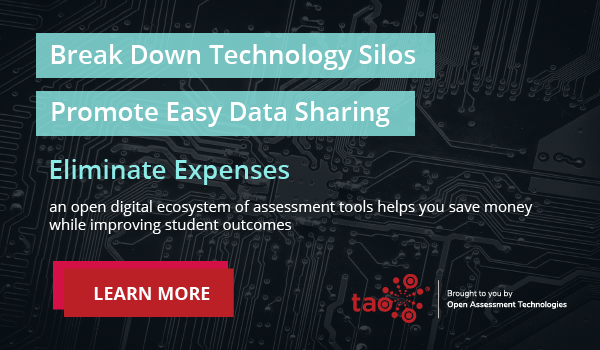Just recently we had the chance to attend the LearnLaunch Across Boundaries conference in Boston, where we sat in on thought-provoking sessions about innovation and the future of education. The atmosphere was buzzing with discussions on education and assessment technology, and the transformative changes happening as digitization takes hold in the industry. Throughout the conference, one common sentiment was clear: the possibilities for advancement in education are endless.
During the sessions, we found the key takeaways to echo the eLearning trends we see pushing the industry forward. Here’s what we came away with:
K12 Classrooms are Embracing AI Assessment Technology…
But AI will not replace teachers. While AI-powered assessment technology has the power to disrupt modern testing techniques, the overwhelming consensus from educators and technologists alike is that AI cannot replace the human touch. Rather, it empowers teachers by freeing up their time, and allows them to give better and faster feedback to students. In fact, a recent study from McKinsey assessed the potential impact of AI on K12 education. They predict that AI technology in the classroom will help reduce the time teachers spend on grading and administrative tasks by 20 – 40%, enabling a greater focus on learning outcomes and individual student needs.
In one session on AI and digital assessment, we heard from Peter Gault, Founder & Executive Director at Quill.org. Quill is an interactive writing and grammar tool for K12 students, powered by Natural Language Processing (NLP). The tool uses NLP to help students become proficient writers by identifying areas that require additional practice.
Assessing writing and grammar is a time consuming task for educators when done manually, often taking up days of valuable instruction time. AI assessment technology like Quill helps educators optimize their time by analyzing language, grammar and student writing logic, ultimately guiding students toward better writing practices. It also helps students practice in weaker areas by adapting content based on the concepts that they struggle with. Students get the personalized learning experience they need, and teachers receive rich real-time data that helps them inform their lessons and provide targeted interventions when necessary.
Interoperability is a Focus
In more than one session, interoperability, and specifically the IMS Learning Tools Interoperability (LTI) framework was a topic of focus. LTI is one of the core interoperability standards that makes seamless technology integration possible. It allows you to launch tools from different vendors — “ranging from simple communication applications, such as chat, to domain-specific learning environments, such as publisher products”– in a single application. By leveraging LTI, you can securely connect your digital assessment platform to an LMS without the need for costly and time consuming custom integrations. Students can then navigate one platform, where their data is retained in a central hub.
Why does this matter? Today’s growing number of cloud-based technologies and EdTech platforms provide ample opportunity for creating innovative digital ecosystems. An open framework allows you to combine best-of-breed assessment tools into a solution that fits your specific needs. And thanks to LTI, not only is student data more accessible, but it’s also protected by a high level of security.
Being Data Informed Improves Performance
While many sessions touched upon the need to be data-informed, corralling data has long been a struggle for educators and school districts alike. Factors like locked systems, time and resources have often stood in the way of using student data to its full potential.
Across EdTech platforms, loads of student data is being tracked — but what is being done with it? For Elizabeth Homan, Assistant Superintendent at Waltham Public Schools, aggregating (most of) her district’s student data into one place was key to untangling the insights available to them. She spoke to the importance of interoperable technology as a means to enable a holistic data flow between systems. The next step? Identifying areas of focus, like what they were looking for and what they wanted to change in order to narrow down the chaos and build the most valuable, insightful dashboards.
An interesting takeaway that Homan shared was about the success of her districts. She notes that her top-performing districts, regardless of socio-economic and demographic factors, are those that are the most data-informed. These districts measure student success factors based on performance, as well as anecdotal data based on survey questions. This gives them a more complete view into the whole student, what matters to them and how they learn.
Harnessing Your Data
Though Waltham Public Schools has a data guru on staff, for many districts and institutions, data analysis can be quite the undertaking. Where resources are limited, a tool like Schoolzilla can make sense of your data — and fast. In the past, the turn-around time for student feedback has been notoriously long. Schoolzilla aggregates student data and produces visually digestible dashboards in near real-time so that you can manage your goals and track success as you go. By integrating a reporting tool like this with digital assessment technology, districts and educators are immediately able to see how effective their curriculum is, and make adjustments accordingly.
—
These ideas have been finding footing in EdTech for some time, but are now taking shape in meaningful, focussed applications. As we enter a new decade in EdTech, we expect to see educational technology, and specifically digital assessment tools, only continue to empower educators and students in their pursuit of learning.


